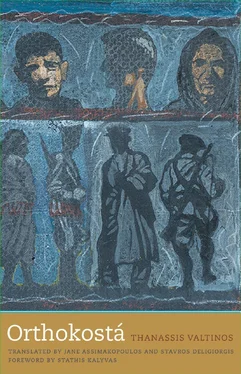The persona of the non-omniscient narrator whom, for convenience’ sake, we can call Valtinos, reappears in later chapters of the book in order to close an epic ring composition and to pose questions that mark him as another local, on intimate terms with various families’ histories and, frequently, an acquaintance of the speakers. There are moments when the questions resemble Socrates’ maieutic method of facilitating the birthing of a story or Homer’s questioning of his hero. The working assumption in Orthokostá seems to have been that the integrity of every testimony would be preserved at all stylistic costs and that all “data,” commented on or not, would be respected as delivered and as recorded. More narrowly, “style” for Valtinos is the projection of the vividness of the medium he salvaged from the mouths of the protagonists of the novel with as little manipulation as possible. The initially choppy, fragmented phrasing of any one of his speakers occurring anywhere in a section may go on for some time, until a particular idiom explodes that cancels out all the inarticulate fumblings leading up to it and brings with it an unforgettable, often surprising turn of thought. The Greek that the obscure villagers of Orthokostá speak, be they in or out of uniform, be they victims or victimizers, communicates an expressive vigor that even under the duress of recollecting the troubled times is nothing short of astounding. The array of the narratives of the novel seems to be saying, Let the people at the receiving end of history talk as they will and two things will emerge simultaneously: on the one hand the kind of local knowledge that the fourteenth- and fifteenth-century chronicles of the Morea — another name for the Peloponnese — or Cyprus, for example, are famous for, and on the other the torrents of live eloquence one associates with Froissart and Xenophon.

The chapters are subtly intertwined, and so are the interludes. The withholding, for instance, of a specific detail for hundreds of pages until its significance is made clear in a new, still shifting context affects the reader’s sense of time and disbelief. And it affirms Valtinos’s sense of the dignity of what would have otherwise been trivial facets of the essentially subjective nature of human experience. Valtinos is so fastidious about not overstating a particular mood he often concludes with aphoristic brevity or by the mere restating of his speakers’ last words.
This book may help explain the attraction Valtinos’s dry, laconic style holds for his readers. The “intermittency” of the Civil War material with the shorter prose poems, besides serving to return the reader to the life of the senses, reveals a Valtinos constantly on the lookout for the other kinds of life going on even among the ruins. Indeed, there are rich doses of Bakhtinian “novelizing” in Orthokostá . Squabbles erupt over a stolen watch. The killing of two ravenous dogs ends in reconciliation. Neighboring villagers who fear a poor citrus fruit crop for that year resign themselves to planting onions. These “gratuitous” minor incidents could be considered as contrastive textures that are inserted in an otherwise torrential series. It is through variations of this kind that Valtinos communicates textual complexity. For lack of a better term they might be called pauses plastiques . They appear as a thematic punctuation in the flow of the longer stories. And they also prevent facile symmetries. Cameo-like, they are breathers permitting the continuous exposition to assume the tones of poetry. Predictability is broken up by the subtle associations afforded by the inserts. Beginning with chapter 3, and ending on the last page of the last chapter of the book, these snapshots are the space in which the unnamed participant observer intrudes the least and sometimes even vanishes altogether. From a literary-historical point of view, alternating the modes of a single composition is part of a tradition that reaches back to the Attic playwrights’ polyrhythms, the Roman prosimetra, and the Christian liturgy. From Ibn Hazm al-Andalusi’s Dove’s Neck Ring About Love of the tenth century and Rigas Feraeos’s Mismayés of the eighteenth there is but a short step to Orthokostá . The contrapuntal, collagistic Orthokostá could not adequately convey a sense of suffering humanity in the round if the uneven chords it struck did not resonate with its readership’s familiarity with other more traditional and more modern projects in music, architecture, and the visual arts. Meaning, in the novel, emerges to a far greater extent from its reading than from its writing.
As the short chapters are mounted in the midst of the longer ones they tend to be emblematic of circumstances as well as of states of mind. In a barely four-line section a woman is asked if she remembered the incident of concealing someone inside a storage trunk: “She started to cry. Poor thing, she’s an old lady now, all shriveled up.” The souls, even of the bravest, as in many of Homer’s martial encounters, depart with a whimper. Valtinos’s snapshots function much like the linguist Roman Jakobson’s continuators, both phatic and evocatory.
Whatever else makes up the chapters of the book is suddenly pushed into the background by the awareness that in the midst of untold calamities a young woman can still be romanced and proposed to by a rebel captain passing through, while another can be coveted by a rightist hothead who can find no other way to be near her except by arresting and re-arresting her; trains are somehow still connecting small townships to county seats; while a handful of naked German soldiers take a dip in a stream of mountainous Arcadia. It is these short, compressed tableaus, in the final analysis, that carry the day. When the agonizing of relatives and friends finally subsides, the last image the last chapter leaves the reader with is of a villager’s speculating over a source of fresh water: if his price is not met, the water will be left to lie in its underground resting place. The site of anguish and fear for the reader is relieved by the hint of an element of life ready to gush forth if only the agency of man would not interfere with it. Even the novelist and critic Edward Dahlberg heard, in his essay “Melanctha” from Can These Bones Live , the clamor and convulsions of the age for “blood, for human offal,” as “a cry for dim and fetal beginnings.”

The cross-layering of human motivations in Orthokostá fast acquires the status of written objects — military operations transparencies, parchment, blotting paper — all in different hands and in different inks rousing the gamut of response from rage and nostalgia to reverie. To the rest of the world the mind of a southeastern Peloponnesian in the early 1940s might well be an enigma. The two pre-forties Greek-American interludes in Orthokostá appear, superficially, to have no relation to the burning issues of the Occupation and the ensuing Civil War. But they do offer glimpses of normalcy (and comic relief) in a society where marriages are arranged for some successful emigrants, while other less disciplined returnees lose their entire life earnings to the fiats of crazed nationalists and ideologues in high places. The women also report on their looted households and the shunting from shelter to shelter of clothing, dowry items, and precious sewing machines, the signifiers of feminine dignity, scattered to the four winds by armed bullies who see no contradiction between their actions and their credos.
By not insinuating any known voice in the master narrative and by not damning either of the fratricidal sides, Valtinos allows scenes of desperate choices to speak for themselves. Even as the Greeks commandeer historic monasteries like Orthokostá and Loukou to “process” future victims, the German occupying forces do their own culling of civilians for the labor camps at home. Does the category of a peasant society whose members are forever enmeshed in the cycles of subsistence farming and the rituals of homemaking explain the violent swings of one group to “liberationist” oppression and of its rival to murderous defensiveness? Through the unfolding of the stories themselves Valtinos distances himself enough to let the reader share in the quizzicality of the events. One woman pretends to be an epileptic — a ploy reminiscent of the Hellenistic romances — in order to avoid deportation to Germany. Only a few chapters later, a group of war-weary individuals volunteers to be taken to camps in Germany in order to escape being exterminated at home! The forces at plague, as James Joyce would have put it, would make idiocy of any attempt at generalizing.
Читать дальше



